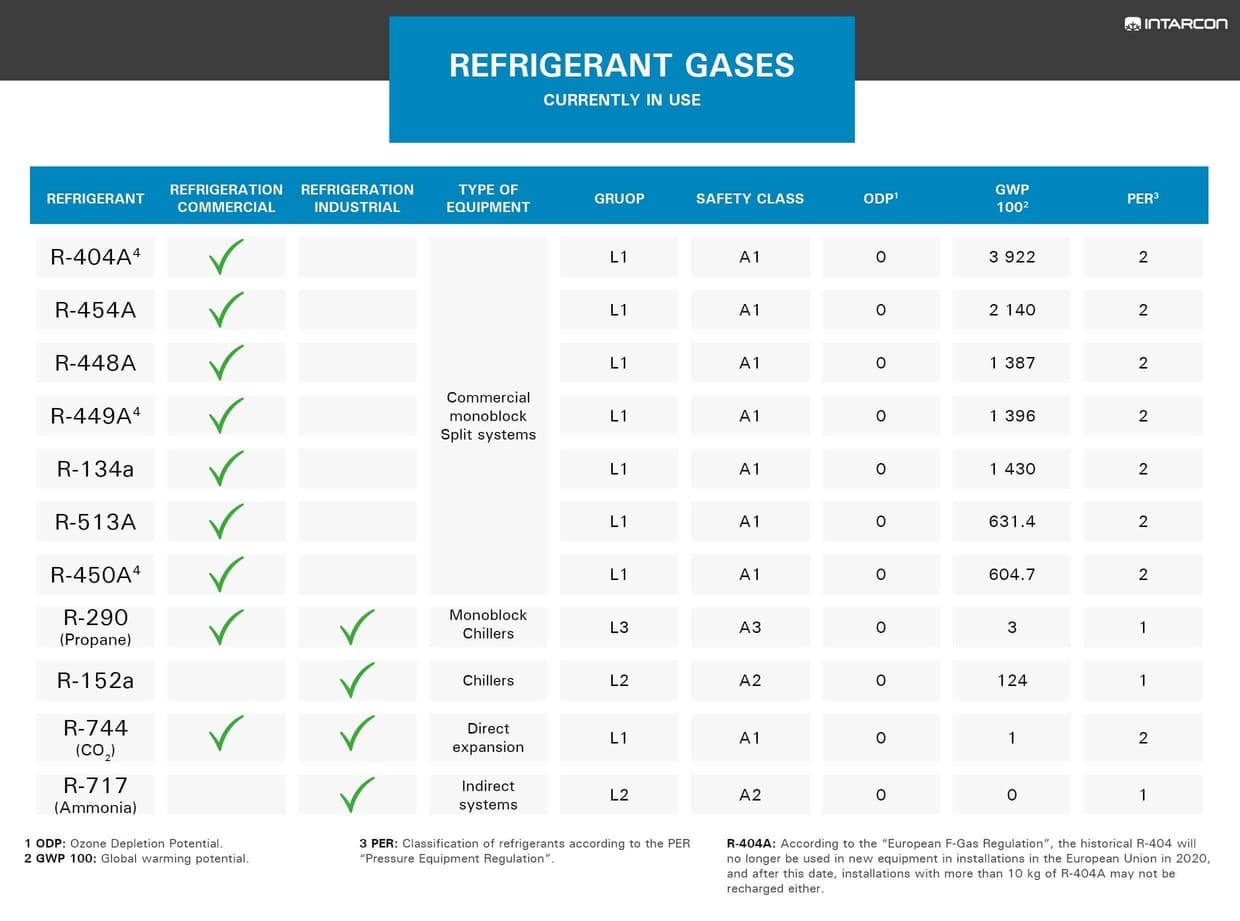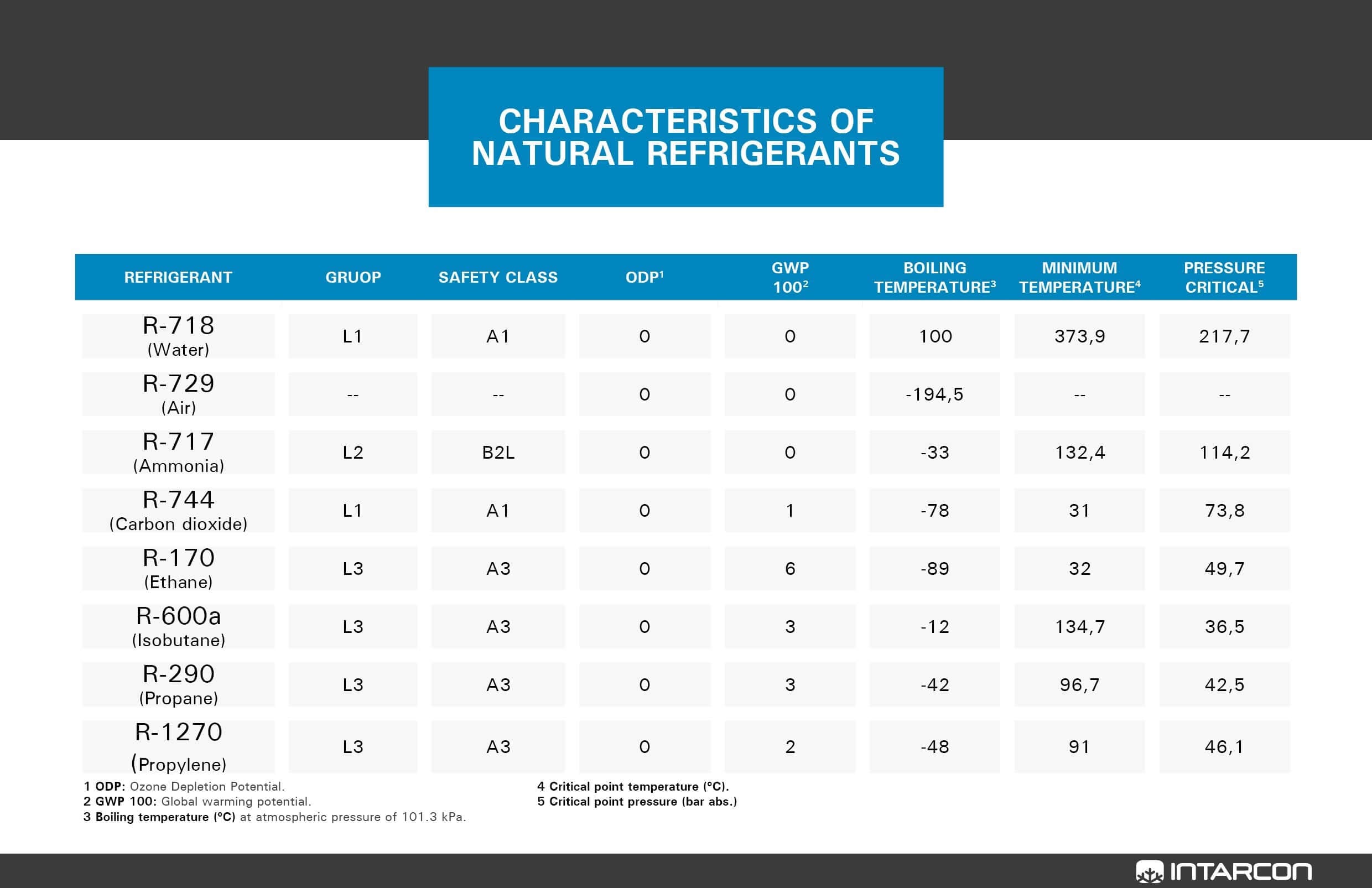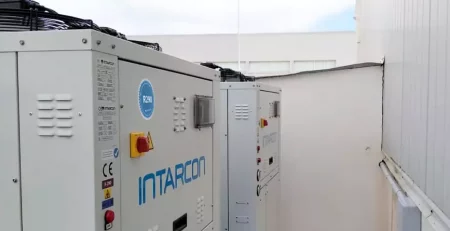Substitute natural refrigerants
INTARCON2023-01-11T17:04:12+01:00With the entry into force of the EU’s F-Gas Regulation 517/2014, we need to find natural replacement refrigerants that allow us to operate our refrigeration equipment properly and as they have been operating until now.
Due to growing concerns about the harmful impact that fluorinated refrigerants can have on the environment, natural refrigerants have made a comeback, especially NH3 and CO2 used for industrial applications at low temperatures.
For this reason, this article has been prepared to provide further information about the refrigerants that are currently being used for refrigeration applications and provide alternatives. We shall discuss the main properties of each alternative eco-friendly/natural gas and their competitive advantages.
Refrigerants used until now
 What are their properties?
What are their properties?
We will analyse the refrigerants that have been most commonly used for commercial applications to understand their properties better:
- R452A: Direct replacement of R404A, but with a moderate GWP = 2140 and a high price. For low, medium and high-temperature applications.
- R449A: With similar properties and almost a direct replacement of R404A, with a GWP of one third less than that of R404A (GWP = 1396), but with a high discharge temperature when used at low temperatures, requiring the installation of a liquid injection system in most cases to cool down the gas.
- R290 (propane: Natural and high-performance refrigerant with a low and stable price, with no risk of obsolescence and a very low global warming potential (GWP = 3) and, therefore, tax-free. It is an excellent refrigerant for low and medium-temperature applications. The only minor drawback is that it is classified as safety class A3 (highly flammable) according to the RSIF, so it requires a series of design and handling precautions to be taken into account.
- R134a: Refrigerant with good properties for medium and high-temperature applications, with a GWP = 1430 and no date of limitation on its use for commercial refrigeration applications.
- R513A: Direct replacement of R134a, but with a moderate GWP = 631 and a high price. For medium and high-temperature applications.
Natural refrigerants
Natural refrigerants are chemical products produced by biochemical processes in nature, i.e., these substances are naturally present in the biosphere. In addition, they are not harmful to the ozone layer (ODP = 0) and have a very low or zero global warming potential (GWP ≈ 0). Moreover, the high efficiency of these refrigerants means they have a lower indirect contribution to the global warming of the planet. These products were already used as refrigerants in the nineteenth century and are now starting to be used again because of their low impact on the environment.
The main natural refrigerants used nowadays in the refrigeration industry are: ammonia (NH3), carbon dioxide (CO2) and hydrocarbons (propane (CH3CH2CH3), isobutane (CH(CH3)2-CH3) and propylene (CH3CH=CH2), in particular, propane). Below are the technical characteristics of these refrigerants, their applications and a comparison of their advantages and disadvantages.
Properties of natural refrigerants
The different natural refrigerants and their main characteristics are shown in the table below:
Ammonia (NH3 / R717)
Ammonia (NH3) has a zero ozone depletion potential (ODP = 0) and a zero global warming potential (GWP = 0). Thanks to its excellent thermodynamic properties, it is a good option for use as a refrigerant fluid in steam compression refrigeration systems, achieving a lower consumption of energy when compared to other refrigerants.
This gas was used as a natural refrigerant before the discovery of freon, when it started to be used for high-power industrial applications, which is also the case nowadays. It offers a good energy efficiency and low cost for these applications. The main field of application is industrial refrigeration with screw compressors, although it is also used as a refrigerant in installations with the absorption of NH3-H2O.
Its advantages as a refrigerant are well known and it has been used as a refrigerant for over a century, achieving temperatures of as low as -70°C. This is an alternative refrigerant for air-conditioning equipment and for refrigeration systems. In addition, it can be used in new and existing units. It has a low evaporation point (-33°C) and a high latent evaporation heat (1371 kJ/kg). Moreover, this gas remains in the atmosphere for a few days, so it is classified as a biodegradable gas.
This refrigerant has been classified by the RSIF (Safety Regulations for Refrigeration Installations and Facilities) as “Safety class = B2L”, i.e., this is a “low flammability” and “high toxicity” gas.
With regards to safety, ammonia can be easily detected because of its special smell. It is highly toxic, so all installations using ammonia must be built according to the international safety specifications and regulations, and they ensure that all highly-skilled operators use PPE at all times.
Most common applications of ammonia
- High-power industrial applications
- Commercial refrigeration: Indirect systems in supermarkets
- Industrial refrigeration: NH3 – CO2 Indirect systems and cascade systems
- Refrigeration for transport
- Thermal storage systems
- Commercial/industrial centrifugal compressors
Advantages
- ODP = 0, GWP = 0
- Good heat transfer properties
- Higher refrigeration capacity than other refrigerants
- Cost-effective, with no risk of obsolescence
- Miscible in water
- Easily detected in case of leaks
- It can be mixed with mineral lubricants, alkylbenzenes or poli-alpha-olefin
Disadvantages
- Toxic
- Costly system
- Use is restricted to only some applications
- Risk of flammability under certain conditions
- Being toxic and slightly flammable, it is not suitable for reconverting systems with existing fluorinated refrigerants
Carbon dioxide (CO2 / R744)
Commonly known as R744 when used as a refrigerant, carbon dioxide (CO2) is a good alternative to replace HFCs (hydrofluorocarbons), since it is not harmful to the ozone layer (ODP = 0) and its global warming potential is equal to one (GWP = 1), taking this last value as reference to determine the GWP of other gases. It is an odourless, colourless fluid that is heavier than air and which has been used as a refrigerant for over a century. Even though CO2 is necessary for life on earth, it is also a Greenhouse Gas (GHG) that can modify the environment if its concentration in the atmosphere increases significantly. This refrigerant is classified by the RSIF as “Safety Class = A1”, i.e., it is “non-flammable” and has a “low toxicity”.
CO2 was used as an early refrigerant before freons, but it quickly fell out of use due to its more complex technology. It has excellent thermo-physical properties, although it poses difficulties due to its low critical temperature value (30.978°C) and its high pressures. It has a much higher volumetric capacity than conventional refrigerants. When used for refrigeration applications at ambient temperatures below approx. 25°C, it performs at the subcritical cycle, while it performs at the transcritical cycle at higher temperatures. It is worth mentioning that, in the case of transcritical systems, work efficiency rates similar to those of conventional fluids require the use of complex cycles (parallel compressor, mechanical subcooling, ejectors, etc.).
This gas has a high thermal conductivity and a high density in its gaseous phase, leading to a good transfer of heat in evaporators, condensers and gas coolers; therefore, these properties allow smaller units to be selected when compared to those using CFC, HCFC and HFC. Also, due to the fact that it has a low pressure drop, the diameter of the pipes can be reduced.
Measures
CO2 is a good alternative for both commercial and industrial refrigeration, but certain safety measures must be taken into account. Bear in mind that CO2 cannot be detected through smell, therefore, as it is denser than air, it can displace oxygen to limits that are harmful to health. As it gives off no odour, it may be the case that, if there is a leak, the technician is not able to detect it. Such characteristics make it vital to pay special attention to leak detection, having an alarm system that can detect and warn in time of the presence of CO2 and having an emergency ventilation system.
Furthermore, the high pressure of the gas when it leaks will cause an explosion, with splashes of refrigerant with residues in solid form at very low temperature and at the speed of sound. Please note that CO2 should never be charged in liquid form when the system is at a lower pressure than the triple point (5.2 bar). If you were to do so, the liquid entering the system would suddenly change state, turning into dry ice and remaining in that state inside the system.
Unlike other natural refrigerants, CO2 cannot be adapted to units, whether new or old. Units must be designed according to the properties of this gas and to the high pressures it must withstand. Finally, when compared to hydrocarbons, one of the advantages of CO2 is that it can be used in installations with no load limits.
Most common applications of carbon dioxide
- Commercial and industrial refrigeration
- Refrigeration for transport
- Compact systems
- Supermarkets
- Direct systems, in cascade, and indirect systems
Advantages
- ODP = 0, GWP = 1
- Non-flammable
- Low toxicity (it is only dangerous in high concentrations)
- High heat transfer coefficient
- High performance, low energy consumption
- No long-term secondary effects
- Cost-effective, with no risk of obsolescence
- High availability, as it is obtained as a by-product of various processes
- It can be mixed with POE, PAG and PVE lubricants
Disadvantages
- Works at higher temperatures and pressures than HFCs and other refrigerants
- In the event of leaks, CO2 accumulates on the ground, displacing air; and as it is odourless, it cannot be detected by smell
- CO2 is only suitable for new systems. As it is a high-pressure and low critical temperature refrigerant, it is not suitable for converting existing fluorinated refrigerant systems
- Costly system.
Hydrocarbons
Hydrocarbons are widely used in today’s refrigeration sectors, thanks to its eco-friendly properties. They are odourless, colourless and have an ODP = 0 and a GWP ≤ 6. They are mainly used in secondary and cascade systems, such as refrigeration systems in supermarkets, chillers with safety systems and in compact units. It is also worth highlighting that, due to their high flammability, the safety requirements set forth must be met and their use is restricted to sealed refrigerant circuits with small loads when the units are installed in enclosed spaces.
Measures
The main measures that must be taken into account in terms of safety entail ensuring that there are no sources of heat at the workplace that could create flames, and no switches or devices that create sparks. Likewise, no smoking is allowed. Moreover, static electricity should be avoided and it must be guaranteed that the work area is ventilated properly, as well as ensure that there are no unauthorised persons performing installation and/or maintenance work. Similarly, these refrigerants must not enter basements and sewer systems, since hydrocarbons are heavier than air, and this could pose a problem if the appropriate measures are not taken.
Technicians installing and/or servicing units containing hydrocarbons must be trained to do so and on handling refrigerants; in addition to have the necessary skills on the use of tools, handling system components and the applicable safety measures, both at the workplace and in relation to staff safety.
With regards to units and systems that use hydrocarbons, exercise due caution to guarantee that there are no leaks in the circuit; likewise, make sure that there are no elements that form sparks.
Propane (CH3CH2CH3 / R290)
Propane or R290 is the most popular refrigerant and is used in many different units, such as heat pumps or compact commercial refrigeration units.
This is a non-toxic but highly-flammable gas, with an ODP = 0 and GWP = 3, so it is fully compatible with the limits established by the F-Gas Regulations. Its thermodynamic properties are similar to those of R22, although it has slightly lower working pressures and capacities. It has good thermal-physical properties and its thermal efficiency is good under most conditions, even at high ambient temperatures, in which it has a low discharge temperature.
It was used until now in medium-capacity sealed commercial refrigeration units, with charge limits in Europe of 150 g/circuit. However, after the possible amendment of the safety standards (IEC 60335-2-89 and IEC 60335-2-40), which are expected to increase the charge limits to up to 500 g/circuit, this refrigerant fluid is also expected to achieve widespread use. It is also used as a component when mixing refrigerants.
When this refrigerant is used, it is necessary to check it to ensure that it is of a high purity, because impurities might contribute to the degradation of lubricant oil in installations or cause wear or faults in some parts. In some cases, hydrocarbons that are not of a high purity can be mixed with other hydrocarbons, achieving heavy variations in the physical and thermodynamic properties of the original hydrocarbon.
Propane is a suitable refrigeration alternative. The units that use this gas achieve a higher energy efficiency and operate at lower costs when compared to those running on fluorinated gases.
As in the case of refrigerants of the hydrocarbon type, propane is also very miscible in any type of lubricant. In some cases, higher viscosity oils might need to be used to compensate this excess solubility.
Moreover, it is also worth highlighting that propane is odourless, so it is hard to detect leaks by smell.
Most common applications
- Compact units with a low refrigerant charge
- Chillers
- Cascade systems
- Secondary circuits (refrigeration units in supermarkets)
Advantages
- ODP = 0, GWP = 3
- Efficient
- Cost-effective, with no risk of obsolescence
- Non-toxic
- Medium-low cost of the refrigeration system
- Good compatibility with other materials (plastic and metal)
- Can be mixed with POE lubricants
Disadvantages
- Highly flammable
- Additional cost in terms of the safety measures required for equipment and personnel
Applicable regulations
- Royal Decree 138/2011, dated 4 February, which approves the Safety regulations for refrigeration installations and their complementary technical instructions.
- Royal Decree 1042/2013, dated 27 December, which passes the fluorinated greenhouse gases tax regulation.
- Law 6/2018, dated 3 July, on the 2018 National Budget. Article 85 (amendment of the previous regulation).
- Regulation (EU) no. 517/2014 of the European Parliament and of the Council, dated 16 April 2014, on fluorinated greenhouse gases. “F-gas Regulation”.
- Royal Decree 115/2017, dated 17 February, regulating the marketing and handling of fluorinated gases and equipment based on them, as well as the certification of the professionals who use them and laying down the technical requirements for installations that develop activities that emit fluorinated gases.







